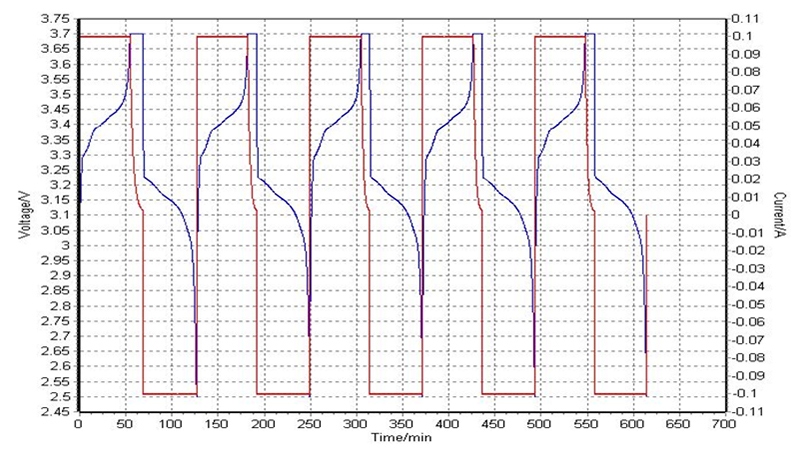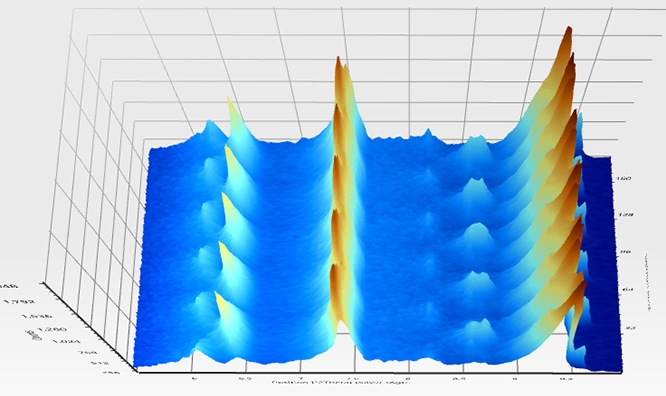This data sheet shows how the Empyrean X-ray diffractometer with 1Der strip detector is successfully employed to measure crystalline phase changes during battery cycling. The Empyrean equipped with hard radiation and the 1Der detector offers you a versatile approach to crystallographic measurements in battery research and production.
The operando (operating) technique enables real-time X-ray diffraction (XRD) characterization of the crystalline phases in battery electrodes. The structural evolution of phases can be tracked during the charge-discharge cycling of the battery. The ion-exchange reaction can be studied under varying operating conditions for a deeper understanding of battery performance, stability and lifetime.
Pouch cells are often used in battery technology research and are increasingly being used for integration into e.g. automotive applications, due to the benefits of cheap and versatile production. Pouch cells can be fabricated with varying thicknesses, sizes and shapes. Used cells are easy to store and recycle.
On the Empyrean XRD system, pouch cells are easy to study in transmission geometry and their flat, often rectangular shape also allows for mapping of measurements at different positions across the battery cell. The 1Der detector is a truly versatile option for this set up, enabling operando battery measurements alongside other more conventional experiments.
The operando (operating) technique enables real-time X-ray diffraction (XRD) characterization of crystalline and amorphous phases in battery materials, including electrodes. The structural evolution of phases can be tracked during the charge-discharge cycling of the battery. The ion-exchange reaction can be studied under varying operating conditions for a deeper understanding of battery performance, stability and lifetime.
Pouch cells are often used in battery technology research and are increasingly being used for integration into e.g. automotive applications, due to the benefits of cheap and versatile production. Pouch cells can be fabricated with varying thicknesses, sizes and shapes. Used cells are easy to store and recycle.
On the Empyrean XRD system, pouch cells are easy to study in transmission geometry and their flat, often rectangular shape also allows for mapping of measurements at different positions across the battery cell. The 1Der detector is a truly versatile option for this set up, enabling operando battery measurements alongside other more conventional experiments.
The transmission configuration for studying a pouch cell is shown in Figure 1. A commercial pouch cell employing a LiFePO4 cathode and a graphite anode is measured during 5 complete cycles of charge/discharge. It is held in a specially designed pouch cell holder on a programmable X-Y-Z sample stage. Ag radiation is used for maximum penetration through the cell and the finest data quality is assured by the special focussing mirror incident beam optic tuned to Ag Kα wavelength. The versatile 1Der detector completes the configuration. With its automatically tuneable energy window, the 1Der can select a narrow window around Ag radiation energy, for a fast powder diffraction scan.

Figure 1. Empyrean configuration for transmission incorporating Ag X-ray tube, focussing mirror and the 1Der detector. The pouch cell battery is mounted in a pouch cell holder on a programmable X-Y-Z stage.
Empyrean platform offers several standard and bespoke electrochemical cell sample holders.
For fully synchronous measurements, the XRD data collection is integrated with the battery charging experiments. Figure 3 shows the voltage and current characteristics for the charge-discharge cycling routine used in this experiment.

Figure 2. Integrated pouch cell holder provides programmable charging cycles for XRD operando studies
HighScore analysis software offers a suite of visualization modes that can bring out different key results from a data set [1]. For example, figure 3 shows the measured data as a 3D plot. Multiple 2θ scans were measured throughout the 5 repeats of the charge cycling routine. These scans are plotted displaced along the near vertical scan number axis. The horizontal axis is the 2θ position for a transmission scan. The 3rd dimension (out of the plane of the page) illustrates intensity peaks via a color scale. The alternating appearance and disappearance of phases throughout the cycling is clearly evident.
Figure 4 shows an example of phase analysis of one of the scans where the 3 major electrode phases LixFeIII1-xFeIIxPO4 and graphite are clearly visible. In this way the relative proportions of material can be quantified for a greater understanding of the ion exchange processes and the quality of the electrode material over time.

Figure 3. 3D plot of measurement data showing multiple 2θ scans collected during the cyclical charging routine

Figure 4. Single 2θ scan extracted from the data set of scans collected during 5 repeated charging cycles of a pouch cell. The identified peaks are colour coded as follows: Blue for LiFePO4, Pink for LixFeIII1-xFeIIxPO4 and green for Graphite.
For a truly multipurpose Empyrean the 1Der gets you data that you can rely on. The automatically tuneable and narrow energy window of 1Der means that you can collect excellent transmission data for pouch cells using hard radiation such as Ag. 1Der has opened the possibilities for a truly wide variety of measurements. With 1Der on Empyrean you can unlock a new sense of wonder and discover more about your materials.
[1] The HighScore Suite, T. Degen, M. Sadki, E. Bron, U. König and G. Nénert, Powder Diffraction 29 (S2), December 2014, S13-S18